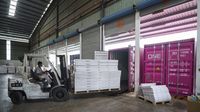Furniture manufacturers in southern Malaysia are racing against time as they scramble to fulfill orders for American customers, driven by the looming threat of tariffs under U.S. President Donald Trump’s trade policies. Following Trump’s announcement of a proposed 24% tariff on all imports from Malaysia, he subsequently revealed that most countries, including Malaysia, would receive a temporary 10% rate for a 90-day period. This unexpected reprieve has led factories in Muar, a key hub for Malaysia's furniture industry, to maximize shipments before the higher duties take effect.
Muar, located in Johor state, is pivotal to Malaysia's furniture exports, with the United States accounting for approximately 60% of total exports. The Corporate Specialist kitchen furniture factory, which exports 100% of its products to the U.S., has ramped up operations significantly. Chief Financial Officer Peihing Tsai reported that the factory has shipped out over 30 containers in just four days—equal to its typical monthly output. "We are working overtime now and trying our best to motivate our workers, because these three months will be very busy," Tsai said.
Trump’s proposed tariffs threaten to increase prices on a wide array of imported goods, including clothing, mobile phones, and furniture, potentially ending a long-standing era of affordable consumer products in the U.S. Tsai expressed concern that if tariff rates exceed 10%, U.S. distributors might abandon Malaysian manufacturers altogether. "The increased price will have to be borne by our end consumers," he added, highlighting the potential economic fallout.
Meanwhile, Candice Lim, general manager at Natural Signature, another furniture maker, views Trump’s tariff threats as more of a negotiating tactic rather than a firm policy shift. "It is unlikely to go on in this way," she remarked, questioning how American consumers would cope with the increased costs. As the clock ticks down on the 90-day tariff window, manufacturers are left hoping for a resolution that will stabilize their export market.
In a related development, the Government of Guyana is also grappling with the ramifications of U.S. tariffs. President Irfaan Ali announced plans to meet with local exporters to assess the impact of a newly imposed 38% reciprocal tariff on Guyanese goods. This tariff, introduced by Trump last Wednesday, was justified by claims that Guyana imposes high tariffs on U.S. goods, which Trump categorized as currency manipulation and trade barriers.
Ali stated, "As we said earlier, the U.S. is a strong partner of Guyana, and we have a lot of discussions and conversations that are ongoing." He has tasked the Minister of Finance to engage with exporters to understand the current circumstances and mitigate the tariff’s effects. Vice President Bharrat Jagdeo echoed these sentiments, noting that the U.S. has a significant trade surplus with Guyana, a fact that complicates the tariff situation.
According to the United Nations COMTRADE, Guyana exported $3.3 billion worth of goods to the U.S. in 2024, while importing $2.56 billion, resulting in a trade surplus of $799 million. However, U.S. figures suggest a much larger surplus for the U.S. at $4.1 billion, which Jagdeo aims to clarify with U.S. officials. He assured exporters that the government would support them to maintain economic output and jobs despite the tariff challenges.
In Canada, exporters are also feeling the pressure from U.S. tariffs, which have led to a surge in inquiries about trade credit insurance. This insurance product, which covers losses due to customer insolvencies, is gaining traction as businesses seek to protect themselves from the fallout of Trump's unpredictable tariff policies. Currently, Canadian exporters insure less than 1% of their overseas payments, even though these account for 40% of their revenue.
Agatha Alstrom, vice president of Insurance and Working Capital Solutions at Export Development Canada (EDC), noted that inquiries about credit insurance have increased by 10% since January. "Tariffs are changing significantly from day to day," Alstrom said, emphasizing the uncertainty that exporters face. EDC is deploying C$5 billion under a government program to assist businesses affected by tariffs, but only about 5% of export businesses currently have credit insurance.
As Canadian exporters brace for potential bankruptcies due to rising tariffs, the demand for trade credit insurance is expected to grow. Michelle Davy, chairwoman of the Receivables Insurance Association of Canada, indicated that the fear of insolvencies is driving this increased interest. "People are afraid," she said, reflecting the anxiety permeating the export sector.
Across the ocean in India, exporters are also adjusting to the shifting trade landscape. The 26% retaliatory tariff imposed by Trump on April 2 took many by surprise, especially since close to 18% of India's merchandise exports are directed to the U.S. The sudden tariff led to immediate concerns among Indian suppliers and U.S. buyers, triggering discussions about pricing and sourcing alternatives.
For instance, BKS Textiles, located near Coimbatore, experienced a slowdown in orders as U.S. buyers began reconsidering their sourcing strategies. Managing director M. Senthil Kumar noted that one customer sought to shift orders to Turkey, which offered a lower tariff. However, the temporary 10% baseline tariff has provided some hope, allowing for a brief respite in negotiations.
Other Indian manufacturers, such as SNQS International, are witnessing a shift in orders from China to India, although they are being pressured to match Chinese pricing, which is 10% to 15% lower. Meanwhile, Alphacraft, an aluminum foundry in Coimbatore, has recently regained orders that were previously lost to Chinese competitors, illustrating the complex dynamics at play.
Despite the challenges, some Indian exporters express optimism. Rajesh Doraiswamy, joint managing director at Salzer Electronics, pointed out that labor costs in India remain significantly lower than in the U.S., making it unlikely that production will shift stateside. However, he acknowledged the potential for increased Chinese imports into India, emphasizing the need for government measures to protect Indian exporters.
As the global trade environment continues to evolve under the weight of tariff policies and negotiations, manufacturers across Malaysia, Guyana, Canada, and India are left navigating uncertainty. The coming months will be critical for these exporters as they adapt to the shifting landscape and seek to maintain their foothold in the U.S. market.








